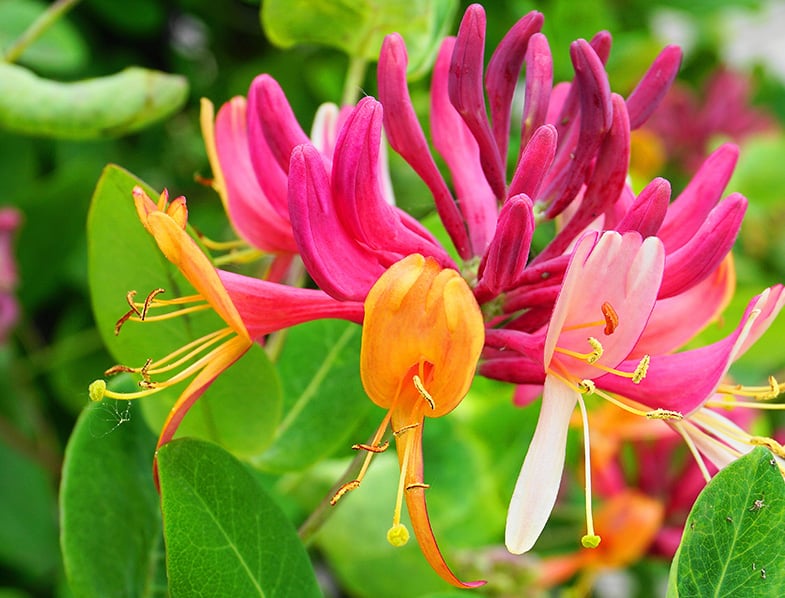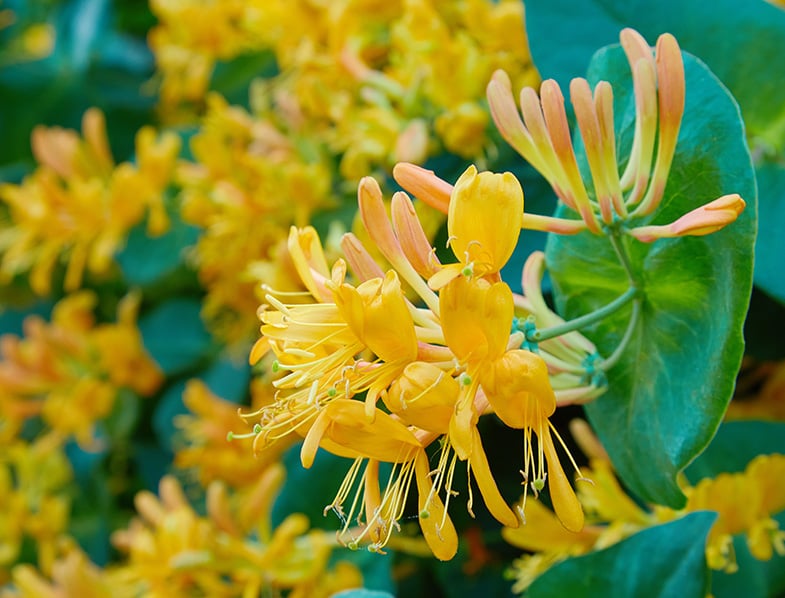Are you looking for an interesting climber to include in your landscape? Look no further than Honeysuckle! Lonicera, commonly known as Honeysuckle, are evergreen, hardy twining climbers or shrubs, covered in clusters of long-lasting tubular scented flowers from summer to late autumn. Honeysuckle is a genus that includes over 180 species of ornamental plants that many gardeners worldwide cultivate for their attractive flowers.
Honeysuckle plants bring a lot of colour and life to any outdoor space. Their sweet nectar attracts hummingbirds, butterflies, bees, and other pollinators. They are also easy to maintain, and their rather messy look makes them perfect for romantic cottage gardens.
Spiritually, honeysuckles are symbols of happiness. Thanks to them being hardy and quite difficult to kill, these plants are also viewed as symbols of devotion and long-lasting bonds.
Certain Honeysuckle species also have medicinal uses. The flowers, the seeds, and the leaves of these plants have a long history of medicinal use when it comes to digestive disorders, respiratory tract infections, fever, urinary diseases, diabetes, rheumatoid arthritis, and many others.
As mentioned above, in some regions, people consider honeysuckles due to their dense growth as they can crowd other native plants. Yet, most species are easy to manage and control, so you shouldn’t avoid them because of their growth habit.
Ready to learn more about growing and caring for Honeysuckle plants? Keep reading below!
About Honeysuckle
- The botanical name of Honeysuckle is Lonicera. Honeysuckle is also known as Woodbine.
- Honeysuckle belongs to the family of Caprifoliaceae, the Lonicera genus, a genus that includes over 180 species of ornamental shrubs and climbers.
- Honeysuckle species are native to temperate zones of both hemispheres. They grow natively in the Himalayas, southern Asia, and North Africa. Most species of Honeysuckle are also present in China.
- Honeysuckle vines and climbers can look amazing in any outdoor space. They are particularly suitable for romantic cottage gardens as they blend in thanks to their messy appearance.
- These plants can have many different purposes in the garden, including providing dappled shade or serving as a lush privacy screen. When the plants aren’t provided with vertical support, they can grow as ground cover and create a fantastic floral carpet.
- Honeysuckle climbers or shrubs prefer to grow in partial shade. The ideal light conditions for these plants involve having shade at their roots and sun at the stems.
- In terms of soil preferences, Honeysuckle climbers prefer to grow in moist but well-drained soil.
- Honeysuckle vines need regular watering during the first seasons after planting. Once established, the plants will only need occasional soak during really hot summers. If you grow them in full sun, the plants will need more frequent watering all year round.
- All honeysuckle species grow best in hardiness zones 9 and 10. Hardy varieties from this genus are hardy to 20 °F (-6.6 °C), zone 8. In moderate climates, these climbers typically need little or no protection from cold temperatures. Frost-hardy species can even survive hard frosts and snowy weather.
- The toxicity of Honeysuckle is subject to the species you are interested in. Some species are non-poisonous, while others are mildly toxic to humans and pets. Mild poisoning with the berries of the plants can be recognized by symptoms like vomiting, diarrhoea, sweats, and increased heartbeat. If ingested in large quantities, symptoms like respiratory failure, convulsions, or even coma can occur. Make sure to check the toxicity of the species you want to plant in your outdoor space and position the climber out of your kids’ and pets’ reach if the species is poisonous.
- Although they are generally hardy plants, Honeysuckles can have some problems with powdery mildew and aphids. Scale insects can also be a problem. These pests attack the plant’s new growth and foliage. If you experience pest infestation with any of these insects, use insecticidal soap to get rid of them.

Honeysuckle Features: An Overview
- Most Honeysuckle species are climbing vines, reaching heights of 10 to 20 feet (10-20 m). Others are shrub or bush honeysuckles, reaching 6 to 15 feet (1,8-4,5 m).
- Most Honeysuckle varieties feature oval leaves that grow opposite each other and sometimes unite around the stem, forming oblong cups. The foliage typically has a blue-green colour, but some species feature dark green or copper-toned foliage.
- Climbing Honeysuckle plants produce scented flowers which are followed by red berries after the petals have passed. Birds love to eat these berries, but they are poisonous to humans.
- Honeysuckles’ flowers have a tubular shape and can vary in colour from pale pastels to rich reds. Most Honeysuckle species produce heavily scented blooms, which act like a magnet for butterflies, bees, hummingbirds, and other pollinators.
Growing Honeysuckle
Caring for Honeysuckle plants is definitely an easy task for both experienced and novice gardeners. These climbers or shrubs are very resistant to a number of things that may be a problem for other ornamental garden plants. Honeysuckles have some specific but minimal growing needs.
First of all, keep in mind that Honeysuckles prefer to grow in partial shade. They can also adapt to full sun, but they definitely perform better in spots with partial shade. In fact, these plants’ ideal light conditions are a combination of sun and shade. They like to have their roots in the shade and their stems exposed to sunlight. If you can’t find a spot in your garden where your Honeysuckle plant will get both sunlight and shade, better choose an area with shade to maintain the moist conditions this plant prefers.
Another thing you can do to help your Honeysuckle plants thrive is to help them with some feeding. Although these climbers or shrubs don’t require significant doses of fertilizers to produce blooms, as most other garden plants need, they can enjoy an annual spring feeding with a general-purpose fertilizer. Avoid overfertilizing your Honeysuckle plants because this can stimulate foliage growth and discourage the appearance of more flowers.
Pruning is another essential step in caring for your Honeysuckles. Pruning helps increase air circulation and light penetration which helps avoid the development of pest infestation with insects like powdery mildew, which thrive in damp and humid environments. Besides that, pruning is also essential to control the sizes your Honeysuckles reach.

200 Pcs Seeds Honeysuckle Seeds, From Amazon
Planting Honeysuckle
The best time to plant Honeysuckle is in spring or fall. These vines prefer cool and moist conditions for their roots to take hold and develop. If you choose to plant your Honeysuckle climber in spring, make sure that the risk of the final frost has passed.
It is essential to keep in mind the ideal growing needs of Honeysuckles when choosing a spot of your outdoor space to plant them. More precisely:
- Choose an area with moist, well-drained soil.
- Choose a location with partial shade.
- Choose a spot that provides enough room for the plant to grow.
To help Honeysuckle develop properly and control their shape and appearance in your garden, give the plants a sturdy frame to climb up, like a trellis or wireframe.
After planting your Honeysuckles, water thoroughly and give them a good soaking once a week until the roots system has developed and established correctly. We also recommend applying a layer of mulch to encourage humidity and moisture retention, which will reduce the plants’ need for watering during the hot season.
Watering Honeysuckle
The most important thing to keep in mind when it comes to watering your Honeysuckles is that these plants prefer moisture and humid conditions in the soil. They require abundant watering during the first seasons after planting and during months with hot, dry weather conditions.
Mature Honeysuckles are more drought-tolerant, meaning that they can survive short periods without proper watering. Still, they will always grow healthier and happier if they are kept in evenly moist soil.
Propagating Honeysuckle
Suppose you want more Honeysuckle plants in your outdoor space. In that case, the amount of work needed can depend on the species you are growing because some species are considered invasive precisely because they propagate on themselves.
You can propagate climbing honeysuckle species by using the berries that occur after the blooms have passed. All you need to do is to extract the seed from the berries and sow them immediately in pots filled with garden soil. After germination in cold conditions, place the seeds in the refrigerator over winter and plant them in your garden after the temperature has reach over 59°F (15°C).

You can also use softwood or semi-ripe cuttings to propagate your Honeysuckle plants. Remove the cuttings from spring to summer and plant them in your garden where you want new plants to grow. We recommend choosing items that have their leaf nodes close together. Take cuttings of no more than 4 inches (10 cm) long.
In Conclusion
Honeysuckle plants can be a joy to have in your outdoor space. They fill your garden with their lovely, sweet scent, attract plenty of pollinators which are also good news for your other plants, and they are also really easy to care for.
Thanks to their unique appearance, Honeysuckle plants can make excellent focal points in any garden, no matter the type of planting style you have in your outdoor space. Climbing species are also a fantastic way to hide an old tree stump or other areas in your landscape that you don’t like. Are you already growing Honeysuckle in your garden? Share your experience in the comments below!
